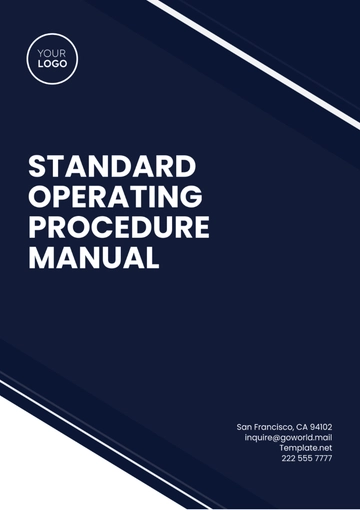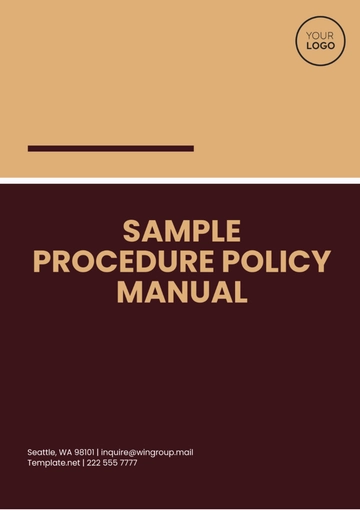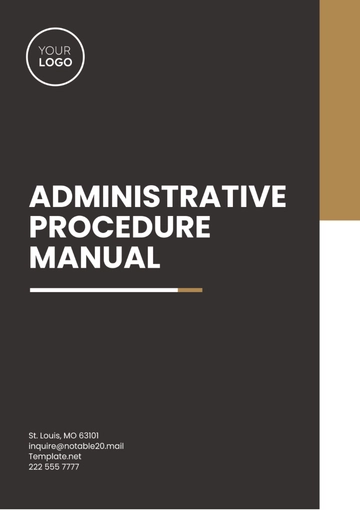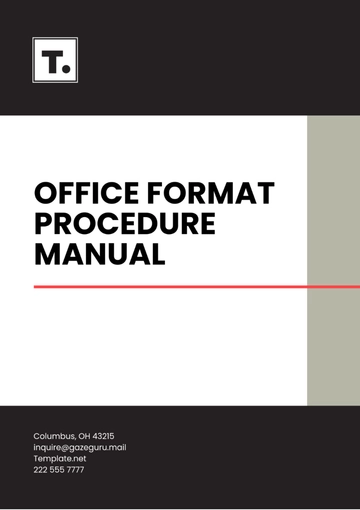Free Finance Mergers & Acquisitions Procedures Manual

I. Overview
Mergers and acquisitions (M&A) stand as transformative milestones in the corporate journey, redefining organizational landscapes and strategic trajectories. This manual serves as a comprehensive guide for stakeholders navigating the intricate terrain of M&A. It lays out standardized protocols, ensuring a seamless, transparent, and successful execution of M&A transactions. By providing a structured framework, this manual aims to enhance understanding and streamline the processes involved in M&A endeavors.
The significance of M&A lies in its power to drive growth, expand market presence, and strategically position our organization in a rapidly evolving business landscape. As we navigate the complexities of M&A, it is imperative to grasp the profound impact it can have on our corporate identity, competitive positioning, and long-term sustainability.
II. Roles and Responsibilities
A. Finance Professionals
Conduct comprehensive financial due diligence, analyzing the financial health and risks of potential targets.
Develop intricate financial models for precise valuation, ensuring accuracy in assessing the target's intrinsic value.
Spearhead financial structuring, optimizing capital deployment, and strategizing deal financing for optimal outcomes.
B. Legal Teams
Safeguard the organization by ensuring meticulous compliance with legal and regulatory requirements at every stage of the M&A process.
Draft, review, and refine transaction documents, securing the legal integrity of the deal.
Provide invaluable legal counsel during negotiations, ensuring alignment with organizational objectives and risk mitigation.
C. Executives
Provide visionary leadership by defining strategic objectives for M&A endeavors.
Exercise decisive approval authority for major decisions and terms of the deal, ensuring alignment with organizational goals.
Oversee the crucial post-merger integration phase, orchestrating seamless assimilation into existing structures.
D. Other Relevant Parties
Collaborate cross-functionally, bringing diverse expertise to the M&A process.
Contribute insights from areas such as operations, human resources, and technology to fortify due diligence efforts.
Uphold organizational values and goals, ensuring a harmonious and well-integrated M&A process.
III. Pre-Transaction Planning
A. Strategic Considerations
Defining Strategic Objectives
Participate in a strategic planning session involving key stakeholders from various departments.
Collaboratively define clear strategic objectives, ensuring alignment with M&A pursuits.
Use SMART criteria to establish measurable goals, such as a 20% increase in revenue, capturing an additional 10% market share, or realizing $15 million in cost synergies within a specified timeframe.
Identifying Potential Targets
Review the checklist of criteria for target identification, incorporating the organization's current market position, technological requirements, and expansion goals.
Specify desired characteristics of potential targets through collaborative discussions, emphasizing factors like a stable financial profile, a strong customer base, or complementary technology stacks.
Assessing Compatibility
Engage the existing task force comprising HR, operations, and cultural experts.
Conduct a cultural compatibility assessment by defining specific steps to identify shared values, organizational philosophies, and work cultures aligning with the organization's ethos.
Develop procedures for assessing operational and strategic compatibility, identifying potential challenges and synergies during integration, considering factors such as supply chain alignment and operational methodologies.
Establishing Measurable Goals
Participate in a metrics-setting workshop with relevant department heads.
Contribute to the development of a collaborative process for setting quantifiable goals, ensuring they resonate with the organization's growth aspirations.
Ensure inclusion of specific targets, such as a 15% increase in customer retention rates, improving employee satisfaction scores by 20%, and realizing a 25% efficiency improvement post-integration.
B. Preliminary Steps
Utilize the existing team comprising market analysts, business strategists, and industry experts.
Review the step-by-step guide for conducting market research, utilizing sources like industry reports, competitor analysis, and market trends.
Clarify criteria for target selection, considering aspects such as financial stability, growth potential, and strategic alignment with the organization's business model.
C. Assessing Compatibility
Operational and Strategic Compatibility Assessment:
Engage the existing task force comprising HR, operations, and cultural experts.
Conduct a thorough operational and strategic compatibility assessment.
Develop processes for identifying potential challenges and synergies during integration.
Consider factors such as supply chain alignment and operational methodologies.
D. Establishing Measurable Goals
Participate in a collaborative metrics-setting workshop with relevant department heads.
Contribute to the development of quantifiable goals resonating with the organization's growth aspirations.
Ensure inclusion of specific targets, such as a 15% increase in customer retention rates, improving employee satisfaction scores by 20%, and realizing a 25% efficiency improvement post-integration.
IV. Transaction Execution
A. Deal Negotiation and Structuring
Deal Negotiation
Form a negotiation team with representatives from finance, legal, and business development.
Develop negotiation strategies and tactics, considering financial, legal, and operational aspects.
Structuring the Deal
Engage financial experts to structure the deal, considering tax implications, financing options, and regulatory requirements.
Collaborate with legal teams to draft a detailed agreement outlining terms, conditions, and obligations.
Conduct thorough due diligence on the potential legal implications of the deal structure, addressing any potential hurdles.
B. Execution and Mitigation
Due Diligence Execution
Collaborate with the due diligence manager to ensure seamless execution of due diligence plans.
Oversee comprehensive financial assessments, legal scrutiny, operational efficiency evaluations, and cultural fit examinations.
Monitor due diligence progress, ensuring representation from finance, legal, operations, and HR departments.
Risk Mitigation
Continuously assess potential risks identified during due diligence.
Collaborate with the risk assessment committee to refine risk mitigation strategies.
Implement contingency plans to address unforeseen challenges, ensuring the smooth progression of the M&A transaction.
C. Post-Transaction Integration Planning
Integration Strategy
Collaborate with cross-functional teams to develop a comprehensive integration plan.
Define specific integration goals, timelines, and key performance indicators (KPIs).
Ensure alignment with the overall strategic objectives and the anticipated benefits of the M&A transaction.
Implementation of Integration Plan
Oversee the execution of the integration plan, ensuring adherence to established timelines.
Monitor key milestones and KPIs to evaluate the success of the integration.
Address any unforeseen challenges promptly, collaborating with relevant teams to find effective solutions.
Implement strategies for smooth employee transition, including onboarding programs and support services.
Foster cultural integration by promoting shared values and communication across merged teams.
Monitor employee satisfaction and engagement levels, addressing concerns proactively.
V. Communication Plan
Effective communication is paramount in ensuring a smooth M& process. The table below outlines key elements of the plan to facilitate transparency, alignment, and stakeholder engagement throughout the M&A journey:
Communication Element | Responsible Party | Frequency | Recipients | Mode |
Integration Kick-off Meeting | M&A Project Manager | One-time (Initiation Phase) | All Employees | In-person Meeting |
A well-executed Communication Plan is integral to the success of the M&A process, contributing to organizational cohesion and achieving the desired outcomes. The Integration Kick-off Meeting serves as the inaugural communication event in the M&A process. Led by the M&A Project Manager, this one-time meeting occurs during the initiation phase and involves all employees. Conducted in-person, the meeting aims to establish a foundational understanding of M&A goals, the expected timeline, and the roles of key team members. By providing this comprehensive overview, the Integration Kick-off Meeting sets a clear trajectory for the entire organization, fostering a shared vision and understanding of the M&A process.
VI. Monitoring and Evaluation
A. Financial Performance
Conduct monthly financial assessments of the merged entities.
Evaluate key financial indicators, including revenue growth, cost synergies realization, and profitability.
Set a target of a minimum 10% increase in overall financial performance within the first year post-merger.
B. Operational Efficiency
Implement quarterly operational efficiency evaluations.
Assess key operational metrics such as production output, supply chain efficiency, and resource utilization.
Aim for a 15% improvement in operational efficiency over the first two years of the merger.
C. Customer Satisfaction
Administer bi-annual customer satisfaction surveys.
Evaluate customer feedback and Net Promoter Scores (NPS).
Strive for a consistent NPS increase, setting a target of 5 points annually.
D. Stakeholder Feedback
Establish a continuous feedback mechanism for key stakeholders.
Conduct annual stakeholder surveys to gather insights on satisfaction with the M&A processes.
Set a goal to maintain a stakeholder satisfaction rating of 80% or above.
E. Employee Satisfaction and Engagement
Implement quarterly employee satisfaction assessments.
Evaluate employee engagement levels through surveys and retention rates.
Aim for a 10% increase in employee satisfaction within the first year post-merger.
F. Performance Insights Utilization
Analyze performance insights gathered from monitoring activities.
Identify areas of improvement and optimization based on data-driven decision-making.
Develop action plans to address any performance gaps and enhance overall M&A effectiveness.
G. Scenario Planning
Conduct bi-annual scenario planning sessions to anticipate potential challenges and opportunities.
Develop contingency plans based on identified scenarios to ensure adaptability.
Implement adaptive strategies in response to changes in market conditions, regulatory environments, or internal dynamics.
H. Key Performance Indicators (KPIs)
Regularly assess KPI achievement to measure the success of the M&A transactions.
Publish a quarterly KPI report, highlighting achievements and areas for improvement.
I. Regulatory Compliance
Implement a semi-annual audit of regulatory compliance within the M&A processes.
Ensure adherence to industry regulations and legal requirements.
Maintain a 95% or above compliance rate to mitigate legal risks.
VII. Regular Review and Update
A. Review and Update Process
Update the manual based on changes in regulations, industry standards, and internal learnings.
Ensure that the manual remains a comprehensive and up-to-date guide for all stakeholders involved in M&A activities.
B. Version Control and Distribution
Implement a robust version control system for the manual.
Distribute updated versions promptly to all relevant stakeholders.
Maintain a centralized repository for easy access and reference, fostering uniformity in M&A processes across the organization.
- 100% Customizable, free editor
- Access 1 Million+ Templates, photo’s & graphics
- Download or share as a template
- Click and replace photos, graphics, text, backgrounds
- Resize, crop, AI write & more
- Access advanced editor
Never start from scratch again with the editable Finance Mergers & Acquisitions Procedures Manual Template from Template.net! This versatile tool, fully customizable, ensures procedural clarity. Tailor effortlessly using our AI Editor Tool, gaining a strategic edge and facilitating successful financial transitions. Customize procedures with ease for a well-organized and efficient process!





























